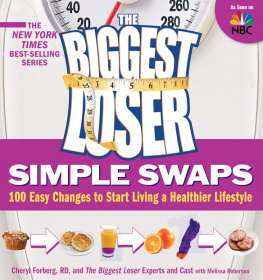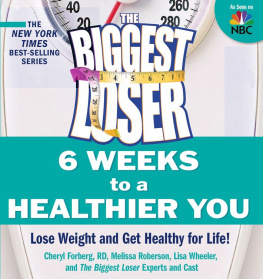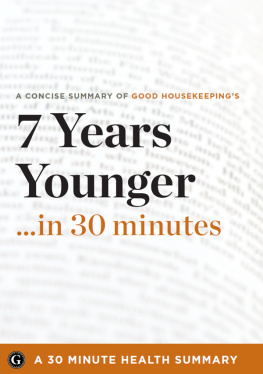ACKNOWLEDGMENTS
T his book would not have been possible without the generous support of a lengthy list of academics, clinicians, and researchers, many of whom I have the honor of calling my friends.
The outstanding scientists I met through the American Aging Association (founded by Dr. Denham Harman) facilitated my initial research. What the libraries could not offer was readily provided by experts such as Donald Ingram of the National Institute on Aging at the National Institutes of Health; Dr. Eric Ravussin, chief, division of health and performance enhancement at the Pennington Biomedical Research Center in Baton Rouge, Louisiana; Dr. Bill Evans of the Nutrition, Metabolism, and Exercise Laboratory at the University of Arkansas; Dr. Ronald Prior of the USDA at the Arkansas Childrens Nutrition Center; and many others. Special thanks to Donna Cini, who made it possible to meet most of the experts.
Many thanks to Dr. Nicholas Perricone for his inspiration and guidance and to Anne Sellaro for her ongoing support and encouragement.
I am so appreciative of my friend and colleague Susan Bowerman, MS, RD, of the UCLA Center for Human Nutrition, who continually opened doors and exchanged ideas with me. She enlightened me to studies I would not have known about otherwise and patiently read sections of the manuscript, discussed many ideas in great detail, and added much value to the final product. Susan, I am indebted for your support and treasure your friendship.
Marie Chrabaszewski, RD, of the Encino Medical Group, provided considerable assistance and support as she generously reviewed the final sections and provided valuable feedback. Thanks for your wisdom, for your humor, and for being so incredibly reliableyou are truly a cherished friend.
Robin Kline, MS, RD, keeps me tethered across the miles with culinary wisdom, scientific curiosity, spiritual guidance, over-the-top generosity, and heartwarming good cheer. I am so blessed to know you!
I am forever indebted to my friends and family who patiently (and diplomatically) tested and tasted my recipes, especially Patricia Treible; Paul Skittone; John and Bette Forberg; Claudia and Rob Hampton; Paul Franson; Karen and Steve Price; David and Erica Ettinger; Paula, John, Jack, and Beau Beritzhoff; Betty Teller; Pam Elder; Leigh Corshen; Julie Logue-Riordan; Carolyn Harber and Bob Fiorella; John Pugh; Gloria Marth; Jill Hunting; Annie Baker; and Brooke Austin. And a special thanks to my friend Bill Frazier, of Frazier Winery in Napa, for the delicious infusions of antioxidant-rich red wine, which made our tastings even more enjoyable.
Diana Erney, senior research librarian of the impressive Rodale Library, provided me with rare published material I did not think was still available. She also shared additional studies that I may never have found nor read. Thank you, Diana, for your valuable input.
Eric Metcalf translated volumes of technical research into entertaining prose. He patiently kept me on the right track and helped me to condense and substantially rethink my ideas concerning this book and this incredibly fascinating topic. Thank you, my friend!
I am thankful to the members of the Food & Culinary Professionals Dietary Practice Group of the American Dietetic Association, the International Association of Culinary Professionals, Les Dames dEscoffier, and the Association of Food Journalists for their knowledge, support, and camaraderie that continually inspire and motivate me.
I am grateful to Chad Bennett and Mark Koops of Reveille LLC, first for selecting me as the nutritionist for NBCs The Biggest Loser fitness reality show. Once I had begun to write this book, they subsequently derailed me with another exciting book project (The Biggest Loser CompleteCalorie Counter), which ultimately gave me the research expertise I needed to understand one of the many facets of this project. I am indebted for your support and for your belief in me and in my work.
Thank you to Dr. Alexa Altman, Dr. Michael Dansinger, Dr. Rob Huizenga, Lisa, Tiare, Jennifer, Terry, Juliana, Elayne, Allison, and Kat, as well as all of the contestants on The Biggest Loser 3. I wish I could list each of you by name. You were with me in spirit as I wrote thisespecially the recipes. I cannot thank you enough for letting me be a part of your transformation and lifes journey. You have each inspired me personally and for that, you have inspired this book.
Amy Super of Rodale, you have been a joy to work with and a wellspring of encouragement. My unending thanks to you for the invitation to meet at Grand Central Station that fateful afternoon. Who knew that a cup of tea and a fruit plate could lead to this?
I must acknowledge those people whose influence extends well beyond this project. Barbara Sutherland, PhD, of the University of California, Davis, has been my mentor and friend since I first attended one of her classes at UC Berkeley. Since then, she has been a perpetual source of support, encouragement, advice, and laughter, which aided my studies, my career, and my life. Thank you, Barbara!
Dr. Bradley Willcox has inspired me (and many others) over the years with his unprecedented research in the Okinawa Centenarian Study. I am indebted for your insights, for your wisdom, and for illuminating this path for me.
My most profound thanks to scientists around the world who devote their work and their lives to the study of diet and disease to afford better health for us all.
FOREWORD
A ging is inevitable. We cannot stop or reverse it, but numerous studies have suggested that we do have enormous control over the rate atwhich we age. My research work, funded by the US National Institute on Aging and the Japan Ministry of Health and Welfare, has focused on healthy aging. In other words, my research attempts to understand why some of us end up living to exceptional ages in good health, like many centenarians who live into the mid to late nineties in vibrant health, and why others dont make it much past their sixties. My work has mainly been with the centenarian population of Okinawa, as co-principal investigator of the Okinawa Centenarian Study, and more recently with long-lived people in Hawaii, as principal investigator of the Hawaii Lifespan Study, a 40-year study of healthy aging in men. Both studies show that lifestyle plays a key role in healthy aging. There is no disputing that genetics is important for healthy aging, but after several decades of research by our team, it is clear that how we live our lives accounts for the greater part of the human life span.
It is easy when one is younger not to be concerned with aging because many of us have feelings of immortality, and most of us do not wish to live to an age where we feel old and decrepit. But we should be concerned. Our research has shown that centenarians achieve such long and healthy lives precisely because they aged more slowly from a young age. In other words, aging is a lifelong process. The early start in healthy aging for centenarians appears to have decreased their risk for many age-associated diseases and has resulted in the delay or, in some cases, complete absence of age-associated diseases, such as coronary heart disease, stroke, cancer, and Alzheimers disease. On the other hand, our 40-year Hawaii Lifespan Study, among the largest and longest studies of aging men ever conducted, shows that midlife risk factors, including diet and physical activity, are extremely important for late-life health. So it really is never too late.







